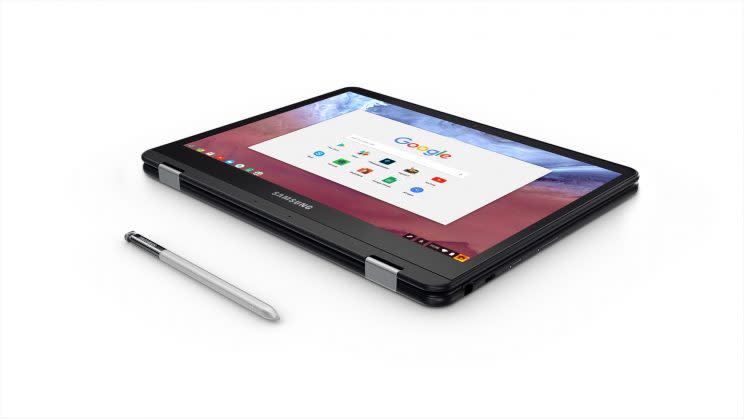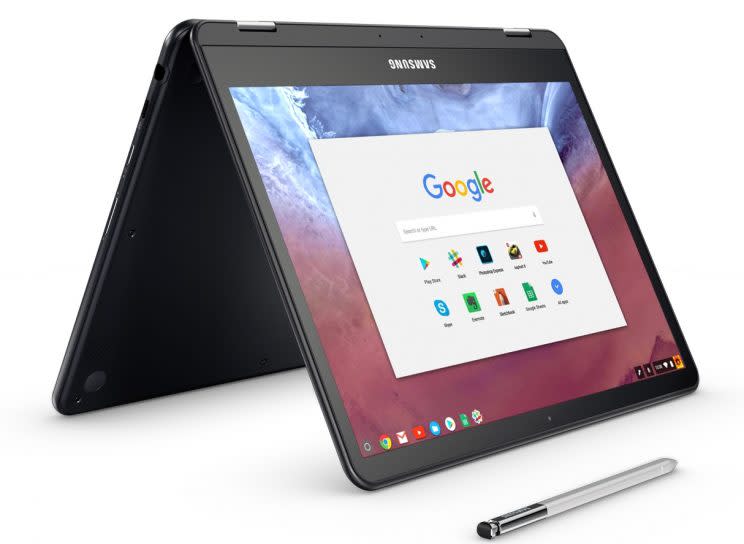Samsung's Chromebook Pro is the best Chromebook yet
Google’s (GOOG, GOOGL) Chromebooks are, by and large, excellent, low-cost alternatives to more expensive Windows PCs and Apple’s MacBooks. They get you online and let you stream movies and music. You can even play a few games on your Chromebook.
And now, with the Samsung Chromebook Plus, available Feb. 12, and Pro, available this April, Chromebooks let you run any of the millions of Android apps available through the Google Play Store right out of the box.
To be sure, the Chromebook Plus and Pro aren’t the first Chromebooks to offer Android app compatibility; three older Chromebooks can already run Android apps via software updates. But these are the first Chromebooks purpose-built with Android apps in mind.
The Plus and Pro aren’t perfect, though. There are still some kinks to work out when it comes to running Android apps on a 12-inch laptop. And they’ve got some stiff competition in the form of Apple’s iPad Pro.
Still, for the first time, I’m genuinely considering buying a Chromebook.
Plus and Pro: The same, but different
Let’s get one thing out of the way before I dive into this review: the difference between the Plus and the Pro. In general, the systems are identical. They share the same design, though the Plus is silver and the Pro is black; the have the same 12.3-inch screen and they both included styluses. Styli? Stylusses? You know what? Let’s just say they both have pens.

The main difference between these systems is their processors. The Chromebook Plus runs on an ARM processor and costs $449, while the Chromebook Pro gets a more powerful Intel chip and costs $549.
How do you decide between the two? Easy. The Plus is meant for basic web browsing and gaming. Think people who check their email or use Google Drive often. The Pro, on the other hand, is for folks who tend to browse the web with 20 tabs open, while streaming music through Spotify and perusing Twitter and Facebook.
Handsome hardware
The Plus and Pro are thin and lightweight at just 0.55 inches thick and 2.4 pounds, respectively. I packed the Chromebook Plus into my backpack along with my regular MacBook Air 13-inch and hardly noticed the added weight.
Unlike most Chromebooks, the Plus and Pro also double as tablets thanks to their 360-degree-hinged, 12.3-inch, 2,400 x 1,600 resolution displays. I watched some movies and browsed the web and found the Pro’s display to be crisp and colorful.
Apple’s 12.9-inch and 9.7-inch iPad Pros are both thinner, lighter and have higher resolution screens than Samsung’s Chromebooks. But Apple’s offerings are also far more expensive. The 9.7-inch iPad Pro starts at $599, while the 12.9-inch model starts at $799. And that’s without the added cost of a keyboard and stylus.
Styling stylus
Speaking of styluses, the Chromebook Plus and Pro’s each have small ports built into their sides to store the pens when not in use. The iPad Pro does not.
Writing with the stylus feels incredibly natural thanks to a bit of added resistance provided by its tip and Google’s machine learning magic.

See, Google has programmed the Plus and Pro to understand how most people write. As a result, the Chromebooks are able to predict how fast you’re jotting something down, and all but eliminate the kind of lag that makes writing with a stylus feel unnatural. The Plus and Pro’s displays are also pressure sensitive — so if you press hard while writing, you’ll see a wider, darker pen stroke.
Keyboard problems
The Plus and Pro are well-built machines, but they do have some problems. Compared to the full-size keyboard on my MacBook Air, the Chromebooks’ keyboards feel cramped, leading me to strike the wrong keys on occasion.
What’s more, the Chromebook Plus and Pro only feature USB C ports, so you’ll need to purchase a separate adapter if you want to connect legacy devices like printers. On the flip side, though, the Plus and Pro is a microSD card slot and headphone jack.
As far as battery life goes, I spent the majority of my day typing away on the Chromebook Pro and didn’t need to plug it in until I got home at night.
Android goes Chrome
It’s great that the Plus and Pro are well-built, but the biggest reason you’d by these Chrome OS-powered machines is that they run Android apps.
Core Google apps like Gmail, YouTube and Calendar all run in Chrome browser-style windows, while a handful of others like Maps and the Play Store run in their own independent, resizable Windows. But third-party apps need a bit more polish.

Twitter (TWTR), Facebook (FB), Netflix (NFLX) and Spotify all run as enlarged versions of their smartphone or tablet versions. Spotify in particular is difficult to navigate, due to the app’s confusing and stretched interface. Hulu also proved bothersome, as the Chrome OS toolbar cut off subtitles.
I also noticed that I couldn’t watch videos in Netflix while browsing the web in Chrome, which was a major pain, especially when I was trying to stream “It’s Always Sunny in Philadelphia” at the office while pretending to do work. Apple’s iPad Pro, on the other hand, lets you stream Netflix and Hulu while browsing the web via picture-in-picture mode.
But again, you’re going to pay a lot more money for that privilege compared to Samsung’s Chromebooks.
Should you buy it?
Sure, you’re not going to get the kind of performance out of a Chromebook that you would out of a more powerful Windows PC or MacBook, but the Plus and Pro will prove to be more than enough for the majority of users.
In other words, if you want a low-cost alternative to your PC, Mac or even iPad Pro, go for the Chromebook Plus or Pro.
More from Dan:
Symantec CEO: ‘It’s a new theater of war’ for cybercriminals
Lego has figured out how to stay relevant in the digital age
Email Daniel at [email protected]; follow him on Twitter at @DanielHowley.
